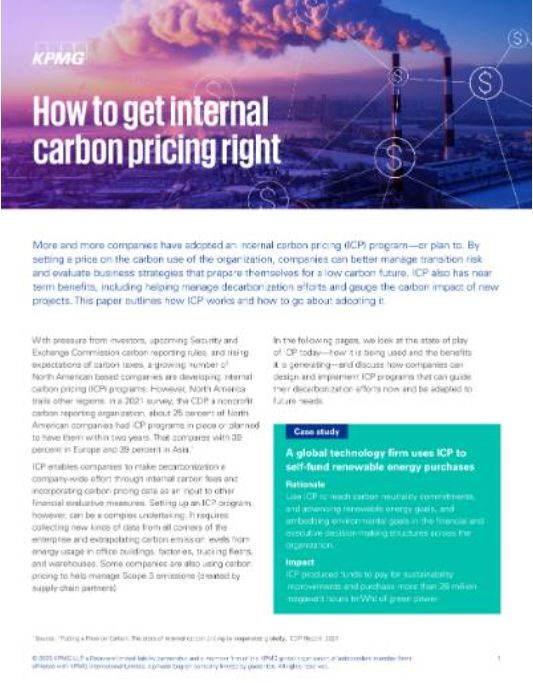The reasons for developing an internal carbon pricing (ICP) programme are growing, as is the number of companies using ICP or planning to. By setting a price on the carbon use of your organisation, your company can better manage transition risks and evaluate business strategies for a low-carbon future.
ICP has near-term benefits too. It enables companies to make decarbonisation a company-wide effort, through internal carbon fees and the incorporating of carbon pricing data into other financial evaluative measures.
Setting up a programme, however, can be a complex undertaking. It requires collecting new kinds of data from all corners of the enterprise and extrapolating carbon emission levels from energy usage in office buildings, factories, trucking fleets and warehouses. Some companies are also using carbon pricing to help manage Scope 3 emissions (created by supply chain partners).
In this paper we look at the state of play of ICP today — how it is being used and the benefits it is generating — and explore how companies can go about adopting and managing programmes to accelerate towards net zero.
What is ICP?
A price used to place a value on the amount of a company’s greenhouse gas or CO2e pollution. Companies that have decarbonisation/energy transition strategies may use ICP to better understand the financial impact of climate risk.
Why it pays to be ICP-ready?
Harnessing an internal carbon shadow price, an internal carbon fee or implicit price can help your organisation reach its decarbonisation goals. Other benefits include:
- Prepares organisations to navigate regulatory environment and quantify impacts of potential regulatory changes
- Provides valuable input and insights into enterprise risk management
- Tracks changes in carbon pricing markets
- Evaluates potential hedging strategies for carbon prices
- Improves internal decision making in understanding the impacts of a carbon price on investment decisions
- Helps identify and seize low-carbon opportunities
- Key input into developing cost abatement curves
- Generates internal funding for decarbonisation investment
- Helps determine value in M&A
- Prepares organisations to respond to upstream supply chain pressures on Scope 3 emissions
- Supports development of procurement strategies to align suppliers to corporate climate objectives
- Helps absorb changes to green-focused government procurement practices
- Challenges status quo helping to define where operations, strategy and go-to-market approaches may need to better align with a carbon-neutral world
- Input to strategic planning to assess risk, market opportunities and business models
- Evaluates price elasticity of pricing strategies that account for carbon pricing
- Improves management of stakeholder expectations
- Attracts environmentally aware investors and builds reputation
- Demonstrates readiness to address climate change concerns
- Enhances performance on climate disclosure requirements
- Provides investors transparency to potential impact of carbon pricing[GRA(M1]
Get in touch
Meeting you wherever you are on your journey, our solutions are designed to help put ESG at the core of your operations. Connect with us to turn insights into opportunity.
Connect with us
- Find office locations kpmg.findOfficeLocations
- kpmg.emailUs
- Social media @ KPMG kpmg.socialMedia




